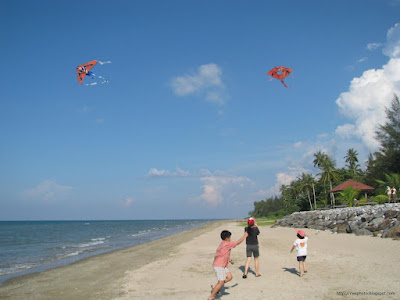These are photos of Palm Beach, Sematan about one and half hours drive from Kuching. Not the Palm Beach at Florida.
 At the background are the Talang Talang Islands.
At the background are the Talang Talang Islands.
A shelter next to the Palm Beach Sematan.
 Jetty near Sematan Bazaar Waterfront.
Jetty near Sematan Bazaar Waterfront. Zoom: Jetty near Sematan Bazaar Waterfront.
Zoom: Jetty near Sematan Bazaar Waterfront.
 Kites flying at Sematan Palm Beach Resort.About Sematan Bazaar
Kites flying at Sematan Palm Beach Resort.About Sematan BazaarSematan is an old seaside
pasar (market) on a rivermouth harbour. Traders from the Malay Peninsula, the Straits and Kalimantan have been coming here for a long, long time. To this day, boats laden with merchandise round the corner of Borneo and fetch up at the jetty in Sematan.
The
pasar has a number of sundry goods and coffee shops where seafood is high on the menu. Look any way you like and you’ll see the sea, or the darkling flank of Gunung Pueh protecting the village!
Gunung Pueh, with winding paths (smugglers’ paths perhaps?) through the forest, its rocks, streams and waterfalls, is one Sematan’s hidden attractions. So is a Selakau longhouse tucked into a quiet valley nearby.
And then – the South China sea!
The shallow waters make Sematan a safe swimming beach.
But beware of Jelly Fish ! Marine turtles nest safely in the sanctuary of Talang-talang islets; some occasionally lay their eggs on the long white beaches, devoid of human footprints, that stretch from Sematan all the way to Tanjung Datus, the westernmost cape of Borneo. Fishermen put out daily, out into the blue deep around the islands scattered offshore. Life proceeds as it has, since time immemorial.
Wheeling Around
The mountain-biking confraternity has discovered Sematan in a big way. These light two-wheelers take their riders practically anywhere, up and down mountain paths, across small streams, along the firm sand just on the tide line; they can easily be loaded into a boat for crossing streams and rocky bays.
On water, there’s more than fishing boats these days. Snappy speedboats take visitors to cruise around the islands, or see the sights from Santubong to Tanjung Datus. Brightly coloured sea kayaks plough the waters, trying to pick up what gentle surf there is.
It is perfectly possible to drive from Kuching for a day of fun, sun and sea, and return in the evening. But it’s a lot better to stay overnight... or a few nights in a row. There are a few lodging houses in the area, even a “homestay village” at Telok Melanau, and a couple of small hotels in the district town of Lundu (90KM from Kuching). Beach resorts, ranging from very basic huts to well-constructed chalets, are springing up.
And then there’s the option of spending a night in a tent under the stars, though this might turn out a bit chaotic if a sudden squall shakes the canvas.
The bottom line: Choose the kind of transport you like and the standard of comfort you require, but don’t miss out on Sematan. It really is the end!
About Sematan Palm Beach ResortSematan Palm Beach Resort (SPBR), is based on chalet-type accommodation. Some are open-plan A-frames with upstairs and downstairs bedrooms, others quadruplex cottages. The Family Rooms consist of two linked rooms which sleep up to six persons... or more. Head counts tend to be liberal, and no big fuss is made over one or two extra persons per room.
The rooms are well built and functional, with air-cond, TV and clean water. But no telephone line. Furniture, fittings, draperies are of good quality; little attempt is made at fancy decorations. The main attraction in Palm Beach Resort is definitely the sea and the landscape — guests don’t sit in their rooms to contemplate faux ethnic curios stuck to the walls!
Sea air, especially when combined with some swimming, beach jogging and kayaking, stimulates healthy appetites. The steady stream of air from the sea make kite flying enjoyable. The restaurant offers home-cooked fare. Dinner and breakfast are included in the standard tariffs. Barbecue pits are available for in-house guests who may choose to manage on their own, or ask for help from the staff.
Palm Beach Resort is becoming the haunt of scuba divers from Kuching and further afield. Such trips have to be arranged beforehand; kayaks and mountain bikes can be rented by anyone game to try, though bikers and paddlers usually come in groups, ready for an exhausting weekend of sport and fun.
Palm Beach Resort also caters for meetings and social functions. It can accommodate up to 120 persons, and there’s never any problem with special requests like wedding cakes.
Contact:
Sematan Palm Beach Resort,
Kg Sg Kilong, Jalan Seacom,
94100 Sematan, Sarawak.
Tel: 082-712 388/711 808,
Fax: 082-711788;























